|
Stuart to the Georgia Border ST. LUCIE INLET
When Knotty Dog was finished, it was time to take it out for sea trials to make sure all the repairs worked properly. They would be looking for leaks in the hydraulic system, and checking to see if the engine room temperatures were lowered. Four of the guys from the yard came on the boat as Larry maneuvered out the river to the St. Lucie Inlet. We had someone representing the bow thrusters and stabilizers and another was the hydraulic specialist. The supervisor from Stuart Boat yard and the supervisor from Nordhavn were there representing both companies. It was slow going out the shallow obstacle ridden river. Larry rubbed the bottom a couple times on the soft mud bottom of the river, even with the help of the locals aboard who said they do the same. “It’s soft mud bottom so no problem” they say.
Everything was running properly except for the stabilizers which required some adjustments. Everyone unanimously agreed that all was in good shape so we decided there was no need to go out to sea or go back in the river to Stuart boat yard. We docked the boat at St. Lucie Inlet Marina and everyone got off but Rick from Nordhavn and Richard from Stuart Boat Yard. They had a few incidentals to do yet. We took them to lunch at Wahoo’s at the head of the dock as a kind of celebration that everything was done.
It was nice to be at a regular dock again with boating people around. We were also glad to have Knotty Dog to ourselves again, though everyone that worked on the boat was very considerate of us and our privacy and not a problem. Larry and I discussed our next stop. We wanted to head on up the coast to St. Augustine but it was a long trip for the two of us (for me not Larry rather). It meant our first overnight run together. I would have to take the shifts on my own. If we went on the outside, we could leave in the morning and arrive the next morning. Otherwise we had a long trip up the ICW and the nerve wracking experience of worrying about the shoals and shallow depths between here and St. Augustine. We decided to due the all nighter. I just needed to get over the fear of doing it just ourselves. I didn’t know if I’d be too tired to do it but I also didn’t want to have to get a crew member every time we needed to go over night. We would have some more areas like this farther north, so it was time for me to get over it.
ALL NIGHTER FROM ST LUCIE TO ST AUGUSTINE
We Left mid morning, and carefully headed on out the channel
to the St. Lucie Inlet to the Atlantic ocean. We had traversed this path on our
way in and it was very, very shallow and was shoaling badly. We weren’t anxious
to go through it again. Just as we got to the bad part a sailboat cut into the
channel. We had to cut our speed down to avoid him and follow him as he headed
down the channel. We couldn’t figure out why he was going so slow. It was hard
for us to keep the boat on track at this idle speed and the currents were
pulling the boat. I got the binoculars out and saw that they were towing the
boat on the side with their dinghy. It was starting to rain again as these
squalls are becoming part of our challenge every time we get into a difficult
situation. As we headed on down the channel farther, the squall became quite significant and a thick haze came through with it. It was so thick that looked like fog and our visibility was zilch. We decided to just stop in the channel until we could see again. We held Knotty Dog in one position the best we could with the help of the bow thruster for about 15 minutes until the “fog” lifted and we could proceed forward. I was telling Larry, that it seems like everything we do is a test. We just can’t go out the difficult channel normally, we have to have buckets of rain, winds, currents, shoaling, shallow water, fog and a derelict boat crossing in front of us. We laughed. Once the fog cleared, we headed on out and it seemed like everyone else was too, like they all came out of the woodwork. I guess they were staying put too until the squall passed through.
It was great to be on the ocean again after all the troubles on the ICW until we noticed that the stabilizers didn’t seem to be working. The boat was rolling and the seas were not bad so something wasn’t right. We were hoping we wouldn’t have to go back now. Larry called the stabilizer guy on the cell phone and on the phone they both were able to adjust the stabilizers until the problem was fixed. What next? Well, all was well. We had a great afternoon, the seas were calm and we were having a great time. I decided to try to get a local radio station and listen to the radio while Larry slept down below getting ready for our long night ahead of us. I was noticing a large black cloudy front heading towards us and bits of lightening flashing here and there. It seemed to stay on the on the mainland and I watched it most of the afternoon. The radio said there were thunder storms and some severe winds which seemed like their typical weather cast. I had been running the boat for about 3 hours and it was late in the afternoon, maybe about 5:00. Larry was going to relieve me so I could make dinner. As I was waiting for Larry to come up, I noticed the wind indicator was going screwy. We had had a consistent 10 knot wind on our stern the whole day and now the indicator was showing zero wind and the dial was circling and skipping all over searching for wind I guess. At first, I thought it must be broken. I mentioned it to Larry as he took over. I also had been watching that big black front getting closer to the boat. I went to the galley and started getting some dinner on. It wasn’t but a couple minutes when Larry called me up to the pilot house. I said I was busy making dinner and he very calmly but firmly answered back that I need to come up to the pilot house. I went up to see what the problem was and told him I was making dinner. He said let it wait, we are going to have some winds and you need to sit up here beside me while it comes. I looked out the window and saw what he was concerned about.
Knotty Dog was holding well and riding the heavy seas but it was a terrifying experience. Ziggy was hyperventilating and we had to hold him. Even holding him did not comfort him or calm him down. Our chart plotter had gone blank about 30 minutes before this experience and deep down inside I was worried that it was going to fail again so I began to chart and record our position in the event that the plotter would completely fail. I asked myself why did this have to happen to us on our first over night alone together. We were being tested at every mark. I wondered why we were going through this. This is supposed to be a vacation and I feel like I’m fighting for my life all the time. Gradually, after a few hours, maybe 3 or 4, the squall had passed over. It stayed with us way too long for my comfort. I kept watching the scary mass on the radar and telling it to get going across to the other side. It was like a blob from outer space. I was just thankful we weren’t out a few more miles in the gulf stream as the current then would have been very strong. They would have been opposing the crazy winds and I can’t imagine what that would have done! Now that would have been an even more frightening experience. I kept telling Larry, this explains the Bermuda Triangle to me. We just experienced it. It was so scary and felt very supernatural. He just laughed.
It was early in the morning as we headed to the St. Augustine inlet. We entered with no problems. The channel entrance was marked well out to sea protecting incoming boats from the notorious shoal that has hooked many a galleon in it’s day. We were surprised to see several shrimp boats heavily at it with their nets draped out fully on each side. It was a long entrance but clearly marked. There are very shallow shoals on each side that have consumed many ancient ships. They are now clearly marked by a breakwater with waves breaking over them.
Immediately to our right was Vilano Beach, a white clean
beach. We were amazed and surprised to see several cars parked right on the
sand and people had set up their lounge chairs and fishing equipment. They were
getting ready to enjoy a day at the beach. Some were fishing, and some
swimming. To our left was Cape Francis and in the distance we could clearly see the St. Augustine Lighthouse. It was a beautiful sight with it’s candy cane red and white strip swirling up to its’ black cupola enclosing it active Fresnel lens. It was stunning and I made a mental promise to make a trip to see it during our stay.
Straight ahead on the land mass in front of us was a tall
white cross. It must have been 100 feet tall and to the left of it was St.
Augustine’s magnificent Fort Castillo de San Marcos. It was in such perfect
condition that this must have been the way it looked back in the days when the
Spanish galleons came to the city. It made for a grand entrance to St.
Augustine. The skyline of St. Augustine was not typical of anything you would
expect in Florida or for that matter the US. It looked like a small town in
Europe. Several tall towers and spires, and a magnificent domed building shaped
the skyline and across the channel to our left was the Bridge of Lions. The
Bridge had two watch towers and powerful but graceful supports holding up it’s
arching bridge. It was truly a breath taking experience and an unexpected sight
as you come by sea. It was by far one of the most picturesque experiences of
our cruising. Many boats were anchored outside the bridge. The City Marina where we were going to stay for a few days was on the other side and we had to wait a few minutes for the first 9:00 bridge opening. Larry did a good job docking the boat though we had a strong current giving it a challenge. The dock manager was an elderly gentleman and very graciously helped us with the lines and whatever we needed. We chatted a little with him and told him about the bad storm we encountered on the way up. He said they had a bad one there the day before and several boats dragged anchor and were blown under the bridge losing their masts and crashed or got caught on the docks.
I guess we are going to have to take these afternoon storms more seriously. They seem to come up quickly and can be quite violent but short.
We really enjoyed our stay in St. Augustine. We made a full four days of it. It was beastly hot and humid and any kind of physical exertion was difficult so we decided to take a tour trolley around town. It was fun to let someone else do the driving for a change. We got a good over view of the town and could then decide which areas we wanted to explore more fully. The trolley was open air and the guide had some sense of humor which was good for a laugh throughout the hour and a half tour. He had a habit of driving faster than I thought was safe on some of the less interesting legs of the tour and the design of the trolleys would blow up debris from the road in your face every once in awhile. The trolley ticket was also like a tram that allowed you could get on and off at different destinations. The second trolley we got on had such bad fumes that we couldn’t stand breathing the exhaust fumes and quickly got off. Regardless, it was fun and helped us cover a big area without walking it.
We quickly found a couple local places to go for coffee and bagels with Ziggy. One morning the four outside tables were occupied by either boaters or locals with their dogs. The dogs are served first and each got double bowled dog dishes of cold water before our orders are even taken. It was great. St. Augustine is a glory of beautiful old buildings that have amazingly survived modern development and are now lovingly restored and displayed. It makes it more interesting to understand it’s history to understand the beauty it has today. It was founded by Spain in 1565 so has a definite Spanish flavor. The most characteristic style that we noticed were the second story porches overhanging into the streets. They are charming. Flagler College is a large anchor to the town and now occupies the old Ponce de Leon Hotel that Henry Flagler built at the turn of the 19th century. It is spectacular in every detail. Flagler was an early major entrepreneur who built the railroad providing the first system for tourist travel all the way from Jacksonville to the Florida Keys. He is responsible for the spectacular skyline of the city as he built the Ponce de Leon Hotel, the church with the dome and the Bridge of Lions.
The city was originally settled by Ponce de Leon as early as 1513. Spain sent the Spanish explorer Don Pedro Menendez de Aviles to rid the area just north of the French Huguenot settlers. He named this harbor for the day he sighted it August 28, the saint’s day feast. Although most of the French fleet that he was after was caught in a hurricane, the survivors were then butchered by Menendez’s men and that’s why the nearby inlet is called Matanzas (slaughter). The town was mostly neglected by Spain for the next several years.
I was surprised to again come across the dealings of Sir
Francis Drake. Boy, that guy sure got around in those days. It seemed our
paths had crossed so many times on this trip of ours, having anchored in Drake
Bay in Costa Rica, read of his rampage in Panama, and so on in so many stops we
had up the Caribbean to Florida. Now we come across this character again.
Apparently he sailed in to St. Augustine in 1586, and as he hated the Spaniards,
he pretty much destroyed their crops and buildings and after succeeding in this
devastation left. This amongst other attacks on the town spurred the Spanish to
build the fort that we saw as we entered.
The Spanish continued to struggle here for the next fifty years without much help from Spain, surviving looting, attacks, several hurricanes and fires. They must have been hearty people. In the early 1700’s, the English again attacked but unsuccessfully. It was not until 1763 that the Spaniards finally agreed to hand over St. Augustine to the British if the British agreed to give up the island of Cuba. Anyway, it’s hard to keep track how many times the city had changed hands between the French, Spanish and English. To make a long complicated history short, the city was finally purchased by the US in 1821 and has been under one flag ever since. The history of this city certainly shows an interesting mix of cultures and styles which makes it truly unique. Henry Flagler certainly added to the mix and style. This city has just about everything you can imagine to see; beautiful beaches, historic light house, architectural treasures, intact fort, Ripley’s Believe it Or Not, and the so called “Fountain of Youth” sought by the explorer Ponce de Leon, and much more. We had 4 days filled with sight seeing and eating and truly enjoyed this stop. We could’ve stayed longer but it was time to go as the fishing tournament was coming to our marina on the day we left and huge tents and digital monitors were being installed and we could tell it was going to get busy. Must not see all so you always have a reason to come back to a place you love. We have so many pictures we want to share we have made a St Augustine photo gallery. It will bring you back to this page. FERNANDINA BEACH
The entry from the ocean is again well out to sea and amazingly marked as this is the channel that the nuclear submarines use to come in to go to Kings Bay submarine base in the Cumberland Sound. We are sure we saw a submarine on the distant horizon that day. It was nothing like we had seen before out to sea. It was a long low image about two football fields long. It was too far away to be sure but we watched most of the day. We were continually buzzed by marine helicopters during the day. We assumed it was because the G8 Conference was going on just up the coast in South Carolina at St. Simmons Island. Maybe they were checking us out because of that or because of the sub or because we were near the submarine base anyway it kept Ziggy busy barking at them and chasing them around the deck.
As we entered the well marked channel we were amazed at
another picturesque fort off our port side. It seemed to be in perfect
condition as if could be set into action at any moment. The antique canons were
perched at precarious locations and were a warning to all who entered at this
close range that they had control. We entered further into the multi faceted
inland waterway here and headed south on the ICW towards Fernandina. We
immediately saw a huge pulp mill ahead of us and it didn’t look very inviting.
We had been asked by someone earlier on the trip why we would want to go there
with the pulp mills as there was nothing to see and I was beginning to wonder.
Another couple had told us it was worth seeing and as I had read that it had 50
blocks of historic homes I was curious. Now, I was getting worrisomely anxious
seeing the overpowering mill and the smoke puffing out into the blue skies.
We continued past and got sight of the marina. They had a long dock that paralleled the ICW and we were to dock on the side. Just beyond the marina we could see the second pulp mill. The marina was sandwiched between two pulp mills. We thought if we didn’t like it here we’d leave and go to St. Mary’s just across the border. We couldn’t go farther north because the G8 Conference had the ICW blocked north and south preventing cruisers from going up and down some of the most scenic areas on the Georgia coast.
We got settled and had lunch on the patio of the marina restaurant. It was great food and we had a great view of the marina and the salt marshes across the ICW. After lunch we took Zig for a walk up the main street and it was charming!
The town is small and almost totally historically intact.
The Victorian buildings are in great shape and lovingly cared for and busy as
they are providing useful office space, retail shops and cafes.
We stayed three nights and thoroughly enjoyed Fernandina
beach. It’s located on Amelia Island. It’s a shrimping village and
we found an excellent local “joint” off the beaten track where we gorged
ourselves on steamed shrimp, hush puppies, and their famous shrimp poor boy. Wow! You’ve never tasted shrimp until you’ve had it
here. After filling up on that good stuff one afternoon we headed up to
the north part of the island to see the original historic district. We got the bikes out for that one and it was hot. It
was a long ride with one stop at the local tavern for a refreshing drink. We found the historic district that was said to be listed on
the national register but not much was left which was disappointing after the
huge effort it took to get there.
The
gentle winds were swaying the marsh grasses and the small pools of muddy waters
were abundant with life and water rings created by the busy bugs. It was
truly glorious so our rewards were great that day. We spent the rest of the days amazed at the friendliness of the Fernandinians. They are so helpful and chatty. I almost dropped dead when two men got up from two separate tables, while they were eating with their families, to open a door for me as I was carrying two cups of coffee to an outside table! Where has the chivalry gone in California? Everyone answers to ”mam” and “sir”, and I mean everyone, man, woman and child. It’s certainly refreshing! We rode the bikes another day across the island to see the Atlantic beach. The long stretches of pristine white beaches lined with clapboard cottages was a beautiful site. Everywhere we went the neighborhoods were well cared for and quaint. There wasn’t boastfulness to the area. It was down to earth.
The island has a colorful history like St. Augustine.
Spain turned it over to the US in 1821 and has been ever since except for the year that the Confederate militia held it for one year during the Civil War. The forces occupied Fort Cinch during that time.
It became a tourist destination for a time until Henry
Flagler built his railroad which by-passed Fernandina. This brought on hard
times as the tourists then rushed south to St. Augustine, Palm Beach and Miami. It
happened so fast that the town was frozen in time and that’s why now it is so
perfectly preserved. It’s like walking back into time. There is a saying by
the locals, “There’s only one F word on Amelia island and that is Flagler.”
Luckily during our visit the wind had been blowing in a
positive direction and we didn’t suffer from the smell from the nearby pulp
mills but as we were getting ready to leave the wind direction changed and we
got a pretty good whiff. Whew! It was getting to be a bit much.
It’s a shame that a perfectly charming town like that is settled between these
two mills.
We enjoyed the long dock at Fernandina Marina. Every early
evening it was like the town boardwalk. Families would walk the dock with
strollers and dogs and loved to make an outing of it. They would chat with you
and sneak a peak into the windows of visiting boats. We chatted with many and
that’s how we got to know how charming these people are. We also found out why
the inner marina was full of mud. I guess it’s Fernandina’s folly.
The Fernandinians seemed embarrassed about it and apologize which we thought was cute. So no boats with any draft at all can use the many docks. Many boats are just plain sitting permanently at dock on the rising mud flat.
CUMBERLAND ISLAND
As we were waiting for the G8 Conference to end and open the ICW we took a local river tour. They welcomed Ziggy which was nice. That day
they didn’t have a full load but took four of us any way. It was a great tour. We learned a lot about the historical tidbits of Fernandina and the people. The
cruise took us to the nearby island of Cumberland, South Carolina. We got a
close up view of the Fort and were told that those awesome silhouettes of canons
are reconstructed from concrete and aren’t real at all but still the place is
awesome.
We motored over and crossed the border between Florida and Georgia to see the absolutely astonishing shoreline of Cumberland Island. We did not know about this island nor that we could have anchored nearby and with the permission of the park service could have been two of 300 people allowed on the pretty much untouched island at one time.
Wild horses wander the island and beaches, originally brought over by the Spaniards. The island is only 17 miles long and 3 miles wild and totally preserved. Some private owners still have a few homes here but it’s basically pristine. The wildlife and flora viewing is like it was hundreds of years ago.
This history of the island has it that a Revolutionary war hero, Nathaniel Green built a home here called Dungeness in the late 18th century. In 1884 the Carnegie family built another mansion over the ruins of the Dungeness. It was later burned by vandals but the amazing ruins are still there leaving an interesting place to explore.
There is the Greyfield Inn, a beautiful turn of the century mansion that now offers rooms and elegant dining to visitors. It’s run by the Carnegie family and is lovingly referred to by many as “Tara on the Beach”.
John Kennedy Jr. was married on this island in
the little historical original chapel that can only accommodate 12 people. The
rest of the wedding group had to stand outside which is normally the corral for
the pigs which gave the locals something to laugh and talk about. The locals
said that John Jr. spent much of his childhood and adult summers there.
NOW ON TO ICW FROM FERNANDINA, FL TO ST SIMONS ISLAND, GEORGIA
|
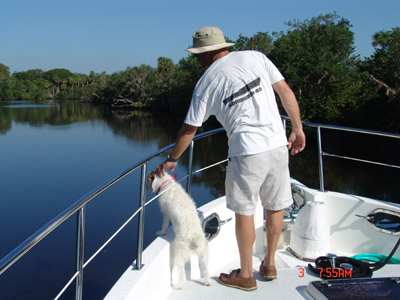
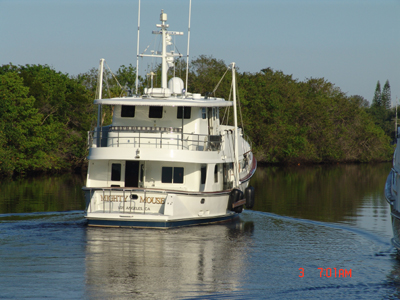
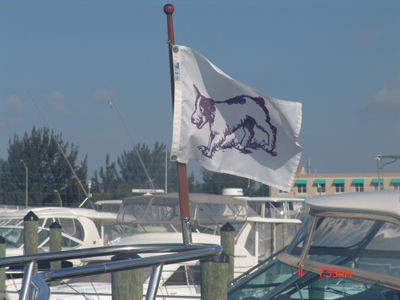
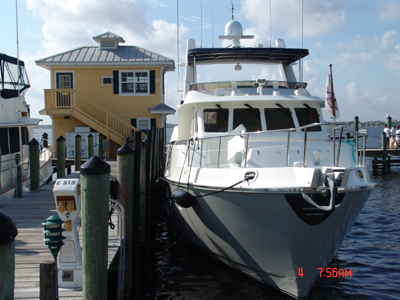
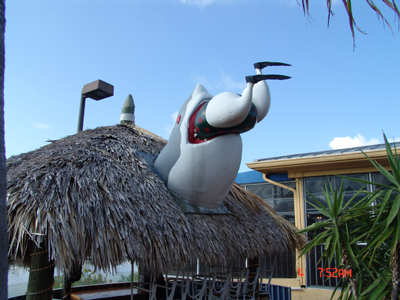
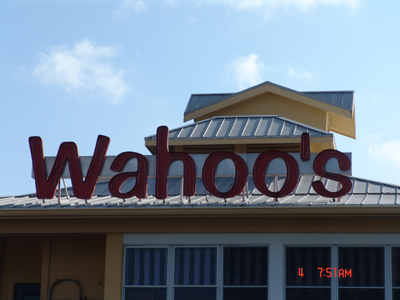
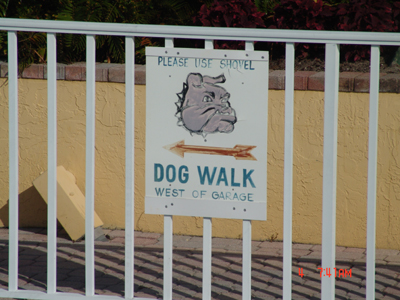
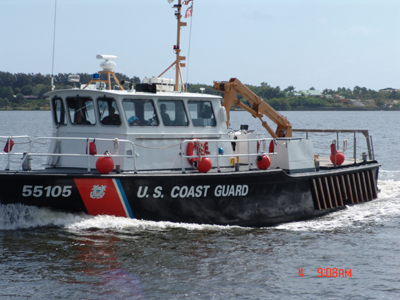
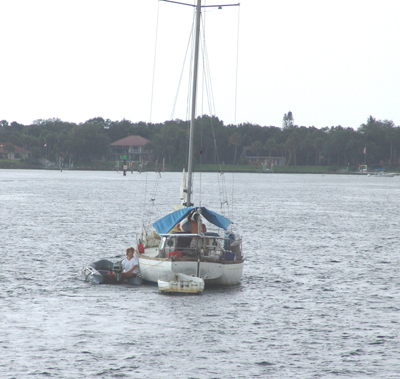 Larry had to speed up a little just to keep Knotty Dog in the
channel against the current. Finally the sailboat got to a place where he could
pull out and we could pick up a normal cruising speed and get around them. As
we neared them to pass, we were surprised to see that the boat was a piece of
junk. It was really a derelict boat and the couple on board looked like they
had been around the horn too many times. No wonder the engine wasn’t working.
Larry had to speed up a little just to keep Knotty Dog in the
channel against the current. Finally the sailboat got to a place where he could
pull out and we could pick up a normal cruising speed and get around them. As
we neared them to pass, we were surprised to see that the boat was a piece of
junk. It was really a derelict boat and the couple on board looked like they
had been around the horn too many times. No wonder the engine wasn’t working.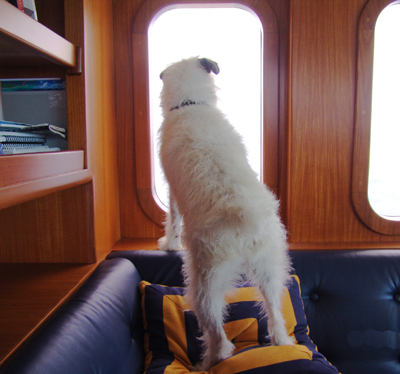
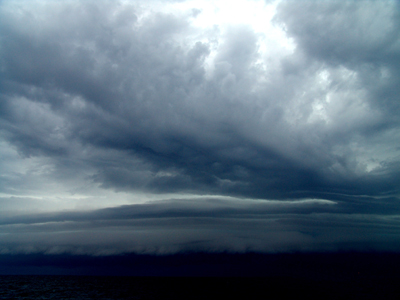 The black front was almost upon us and across the water I
could see a definite line heading towards us. Behind the line the water
was white like snow. It was a mass of white caps but they were so short
and so many that they just look like a white mass. I’ve never seen
anything like it. As it quickly headed towards us, I glanced up at the wind
indicator and all of a sudden the wind was going from 0 to 5 to 10 to 15 20, 25,
30, 35,40, 45,48 and finally to 52 knots!!! It happened so quickly.
I rattled the numbers off as they increased. Larry said “wow”! I
just sat down in the other helms chair and we both just sat silently and watched
this phenomenon. As the winds hit above 50, the boat started to heal over
slightly but amazingly held it’s ground. The water all around us was white
like snow and the sky was black. The winds gradually dropped back down and
settled at 35-40+ knots for the next couple hours. The winds now were
coming on our port forward quarter. The swells had been coming on our
stern for most of the day and now the winds were hitting them square in the face
creating rough crazy seas. They continued to build for the next two hours.
We just sat together and watched this amazing sight. The thunder and
lightening accompanied the winds and strange seas. It was terrifying.
It was like the thunder and lightening was striking right by us. We had
never experienced anything so terrifying. Our radar screen was just a
brilliant yellow mass. We had no visibility and no radar visibility for
hours. We heard the coast guard on the radio giving warnings and we
decided to call in our position to them.
The black front was almost upon us and across the water I
could see a definite line heading towards us. Behind the line the water
was white like snow. It was a mass of white caps but they were so short
and so many that they just look like a white mass. I’ve never seen
anything like it. As it quickly headed towards us, I glanced up at the wind
indicator and all of a sudden the wind was going from 0 to 5 to 10 to 15 20, 25,
30, 35,40, 45,48 and finally to 52 knots!!! It happened so quickly.
I rattled the numbers off as they increased. Larry said “wow”! I
just sat down in the other helms chair and we both just sat silently and watched
this phenomenon. As the winds hit above 50, the boat started to heal over
slightly but amazingly held it’s ground. The water all around us was white
like snow and the sky was black. The winds gradually dropped back down and
settled at 35-40+ knots for the next couple hours. The winds now were
coming on our port forward quarter. The swells had been coming on our
stern for most of the day and now the winds were hitting them square in the face
creating rough crazy seas. They continued to build for the next two hours.
We just sat together and watched this amazing sight. The thunder and
lightening accompanied the winds and strange seas. It was terrifying.
It was like the thunder and lightening was striking right by us. We had
never experienced anything so terrifying. Our radar screen was just a
brilliant yellow mass. We had no visibility and no radar visibility for
hours. We heard the coast guard on the radio giving warnings and we
decided to call in our position to them.
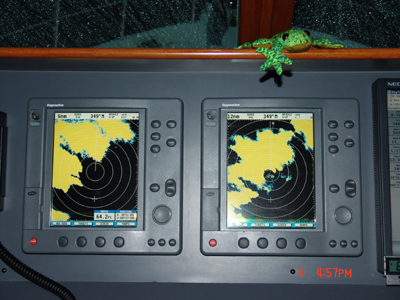 They didn’t respond back right away which made my heart beat
a couple extra beats thinking that not only could we not see anything, now no
one could hear us either. Finally, they answered back and we gave them our
position. They asked if we were OK and needed assistance, we answered back
“no but just wanted you to know we were out here in case anything happens”.
They didn’t respond back right away which made my heart beat
a couple extra beats thinking that not only could we not see anything, now no
one could hear us either. Finally, they answered back and we gave them our
position. They asked if we were OK and needed assistance, we answered back
“no but just wanted you to know we were out here in case anything happens”.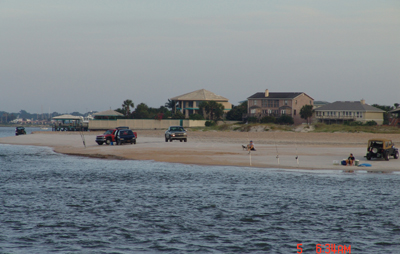 We managed to take turns sleeping on the settee in the pilot
house that night as the waters became calmer and calmer throughout the night.
We (or me) wanted to stay near each other after that horrible experience rather
than going down below to the stateroom. It was comforting to have Larry
nearby. By morning we were nearing our destination St. Augustine on the
northern reaches of the East Coast of Florida.
We managed to take turns sleeping on the settee in the pilot
house that night as the waters became calmer and calmer throughout the night.
We (or me) wanted to stay near each other after that horrible experience rather
than going down below to the stateroom. It was comforting to have Larry
nearby. By morning we were nearing our destination St. Augustine on the
northern reaches of the East Coast of Florida.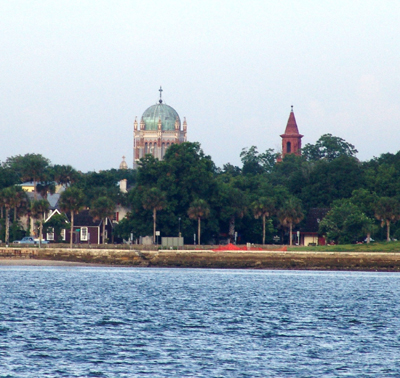
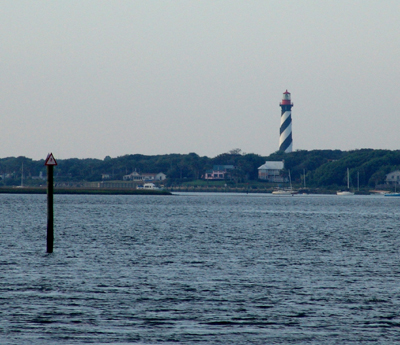
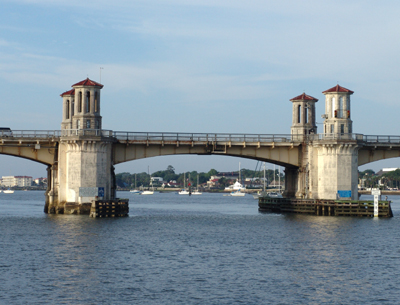
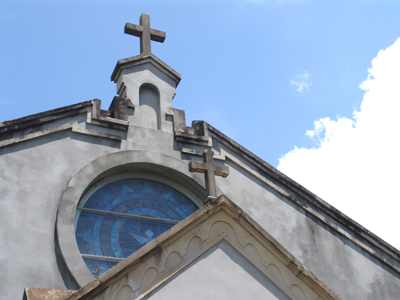
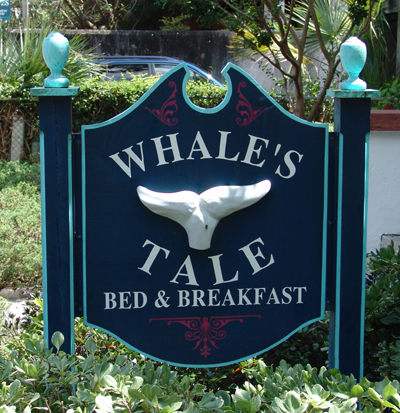
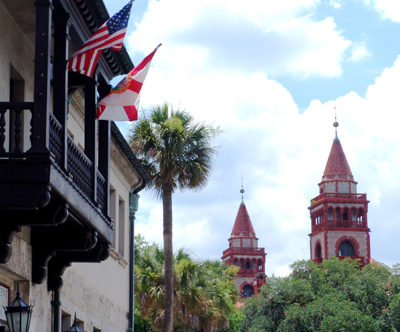
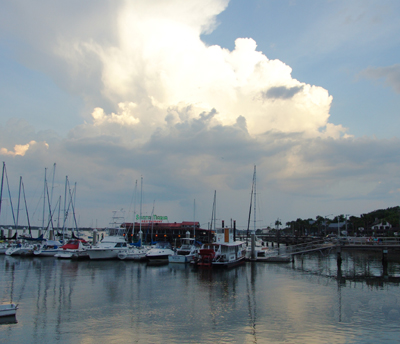
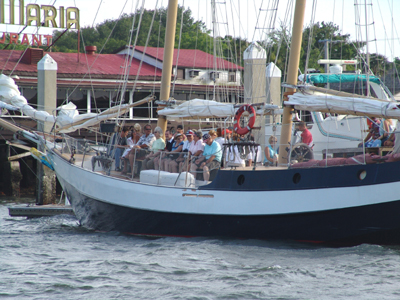
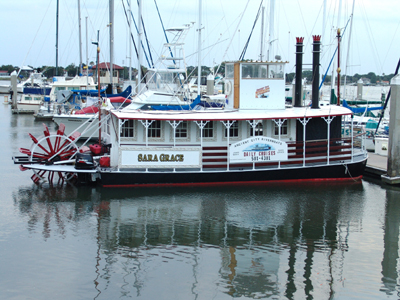
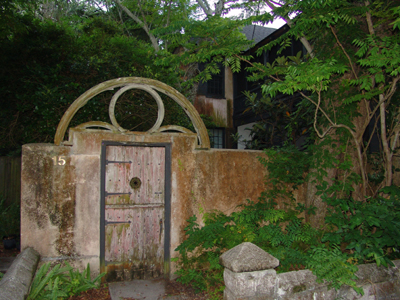
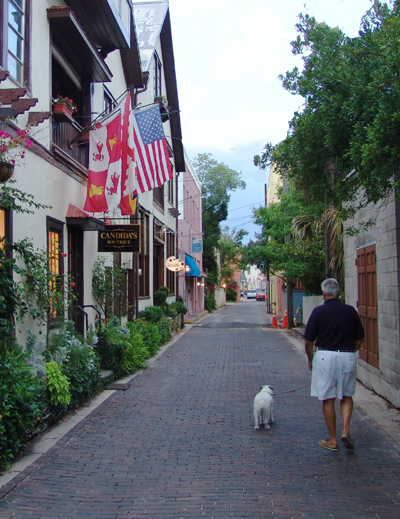
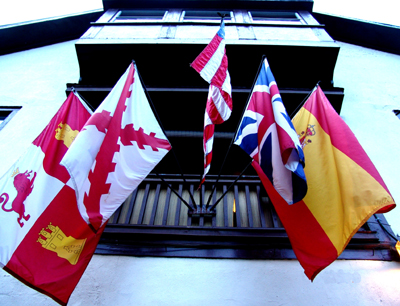
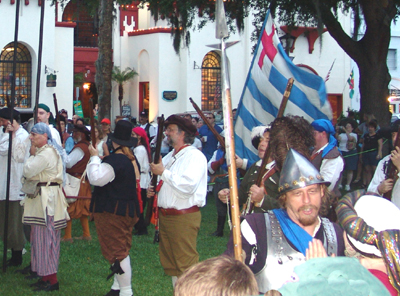
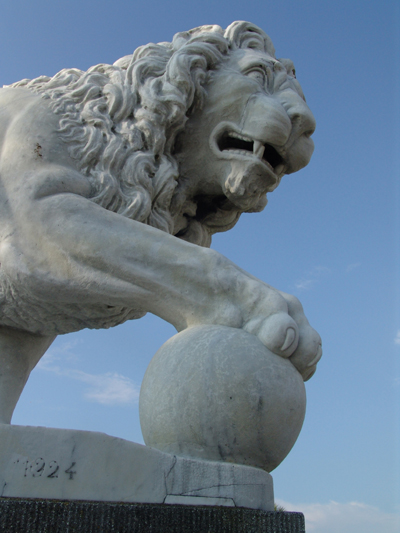
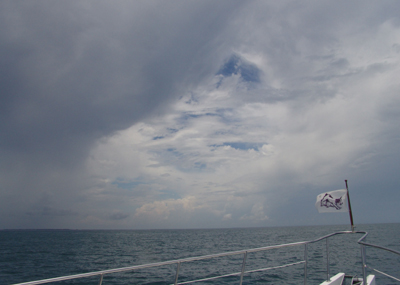 Our next stop north would be our last stop in Florida and
then on to Georgia. Our cruise north was a short day and we should arrive in
Fernandina about 2 or 3 in the afternoon (just before the notorious afternoon
thunder showers). We left St. Augustine the same way we came in and had an easy
day at sea. We decided to give the ocean another shot as the ICW (Intracoastal
Waterway) was too shallow for our liking. It is good to attack your demons and
get over the fear. It was a nice cruising day and no storms.
Our next stop north would be our last stop in Florida and
then on to Georgia. Our cruise north was a short day and we should arrive in
Fernandina about 2 or 3 in the afternoon (just before the notorious afternoon
thunder showers). We left St. Augustine the same way we came in and had an easy
day at sea. We decided to give the ocean another shot as the ICW (Intracoastal
Waterway) was too shallow for our liking. It is good to attack your demons and
get over the fear. It was a nice cruising day and no storms.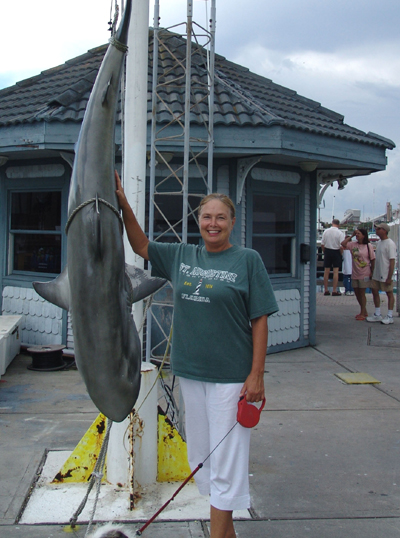
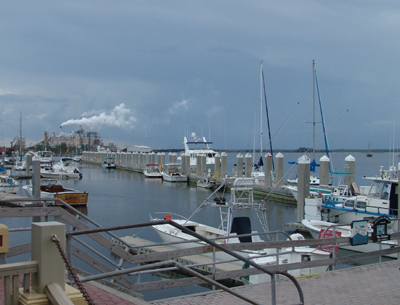
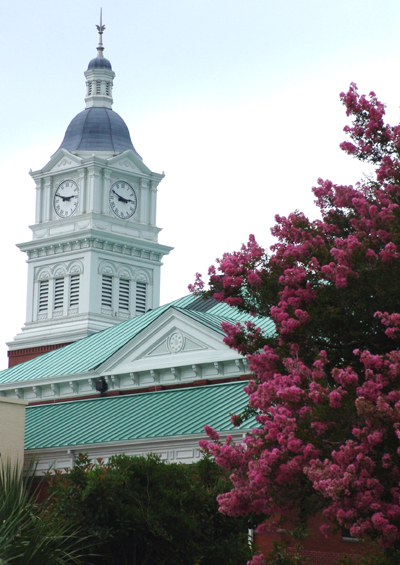
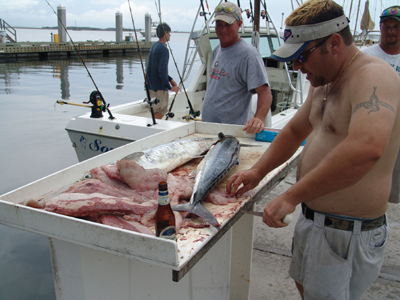
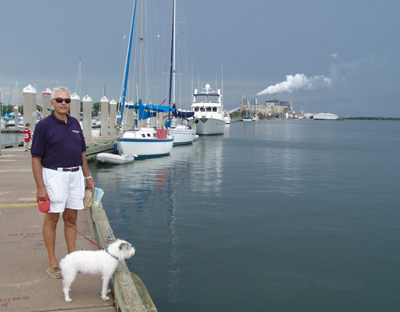
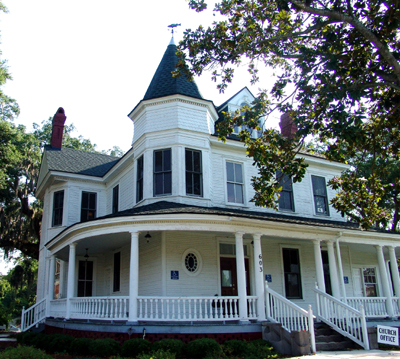
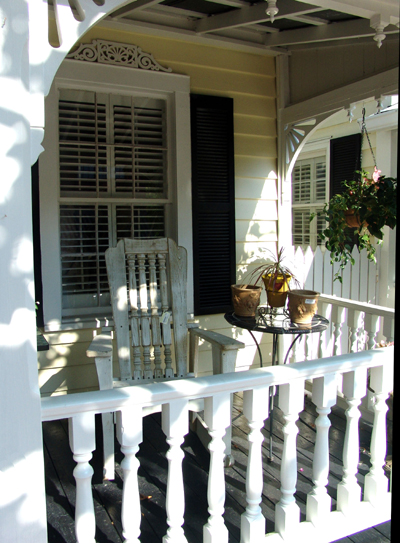 There are many restaurants and interesting shops. The
side streets are lined with beautiful old grand homes in great condition.
The architectural styles range from Queen Anne, Italianate and Florida
vernacular. The gardens are well cared for and the streets are shaded by
tall beautiful trees, many that are flowering. It is the perfect town.
There are many restaurants and interesting shops. The
side streets are lined with beautiful old grand homes in great condition.
The architectural styles range from Queen Anne, Italianate and Florida
vernacular. The gardens are well cared for and the streets are shaded by
tall beautiful trees, many that are flowering. It is the perfect town.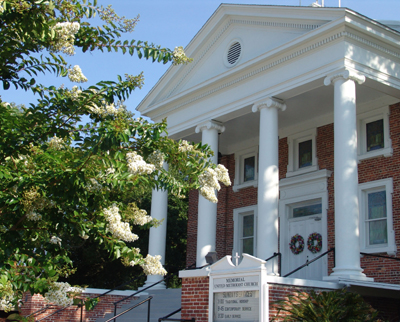
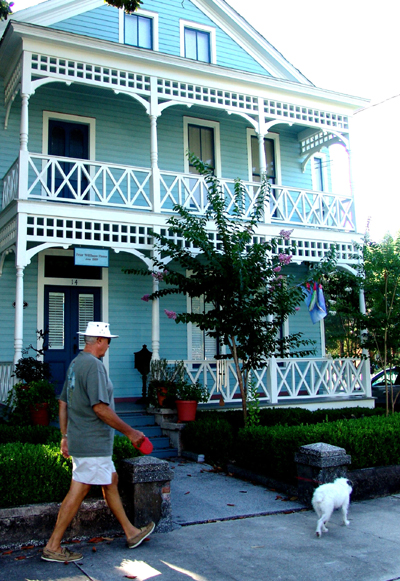 We saw the old house that Mary Pippin was filmed and that was
about it but we were rewarded up the rode a little by see the northern shore
marina nestled into the salt marshes. We were bowled over by the natural scenery and the buzzing of
dragonflies riding tandem whipping across our paths.
We saw the old house that Mary Pippin was filmed and that was
about it but we were rewarded up the rode a little by see the northern shore
marina nestled into the salt marshes. We were bowled over by the natural scenery and the buzzing of
dragonflies riding tandem whipping across our paths.
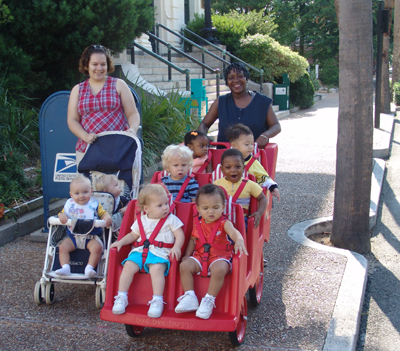
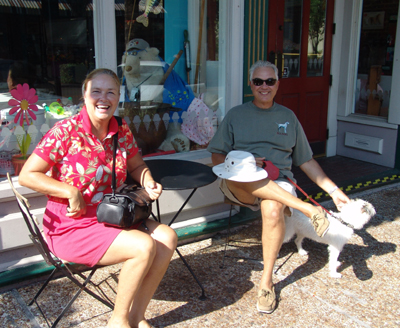
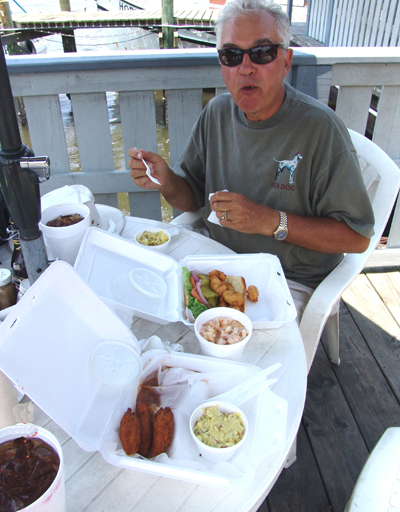 It was originally settled by the French unlike St. Augustine
that was settled by the Spaniards. The French quickly built a fort here on
land originally claimed by the Spanish and declared it theirs. Don Pedro
Menendez del Aviles launched two attacks from St. Augustine and slaughtered 600
French settlers. In the early 1800’s Amelia island was a land port for the
black market trade during the Jefferson Embargo. It was the home of pirates and smugglers. Slave and rum
trading was rampant along with prostitutes. It changed hands many times
and boasts to have served under eight different flags. That included among
them the Spanish, the French Huguenots, the British Union Jack and the
Confederate. It has a colorful history that’s for sure and they are proud
of it.
It was originally settled by the French unlike St. Augustine
that was settled by the Spaniards. The French quickly built a fort here on
land originally claimed by the Spanish and declared it theirs. Don Pedro
Menendez del Aviles launched two attacks from St. Augustine and slaughtered 600
French settlers. In the early 1800’s Amelia island was a land port for the
black market trade during the Jefferson Embargo. It was the home of pirates and smugglers. Slave and rum
trading was rampant along with prostitutes. It changed hands many times
and boasts to have served under eight different flags. That included among
them the Spanish, the French Huguenots, the British Union Jack and the
Confederate. It has a colorful history that’s for sure and they are proud
of it.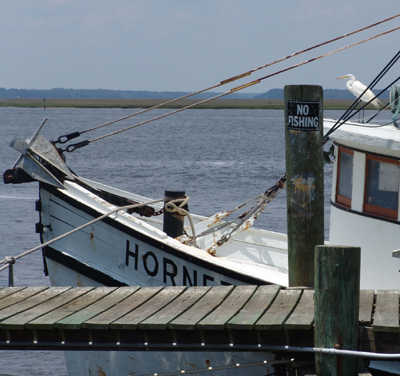
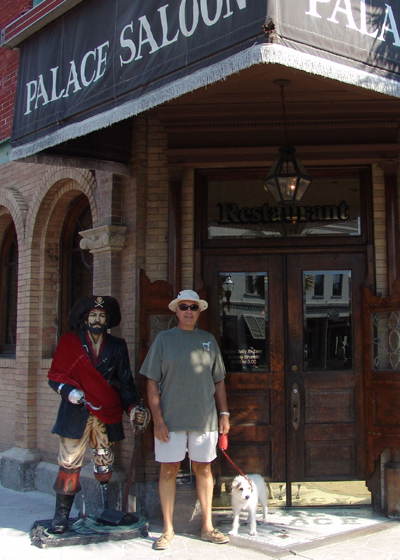
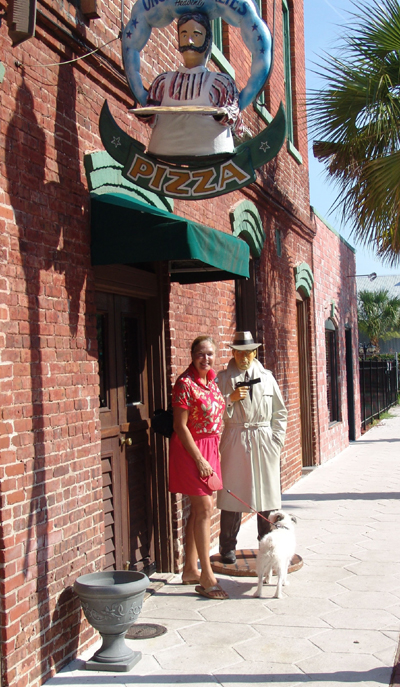 They are in constant site and we noticed foam like flotsam in
the marina that we think was coming from the mills. The people are proud
of their mills though and support the whole heartedly as it employs 800 people
so it is very important to their survival.
They are in constant site and we noticed foam like flotsam in
the marina that we think was coming from the mills. The people are proud
of their mills though and support the whole heartedly as it employs 800 people
so it is very important to their survival.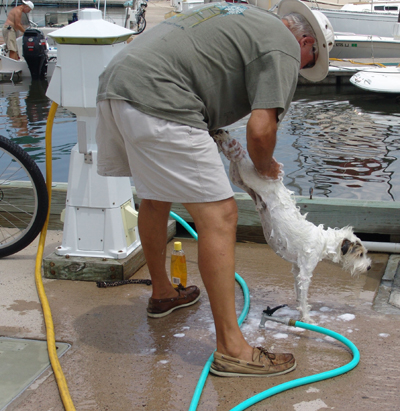 They built
this beautiful brand new marina with a great restaurant, stores and new docks
and the engineering didn’t take into account the silting from the ICW currents
and the mud continues to flow inside the marina. It is slowly filling up with
mud.
They built
this beautiful brand new marina with a great restaurant, stores and new docks
and the engineering didn’t take into account the silting from the ICW currents
and the mud continues to flow inside the marina. It is slowly filling up with
mud. 
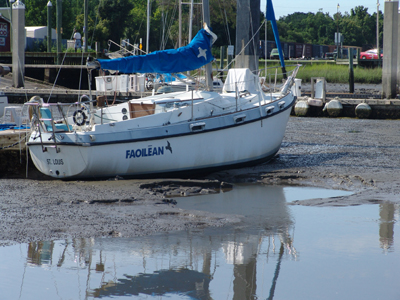
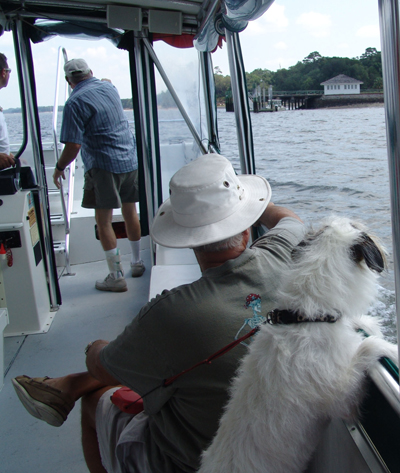
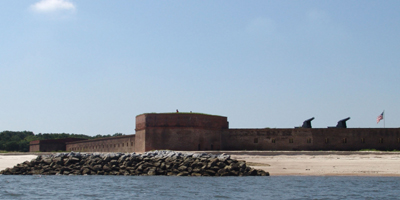
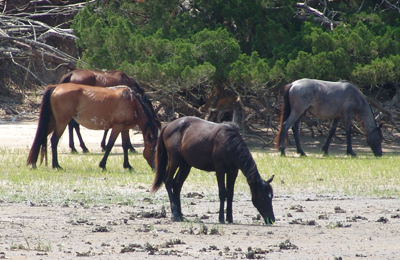
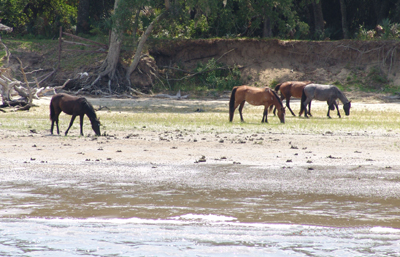
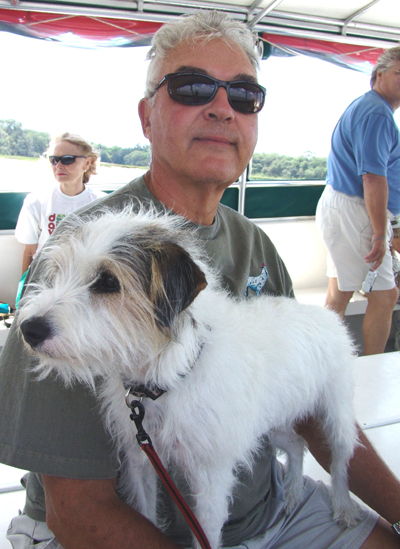
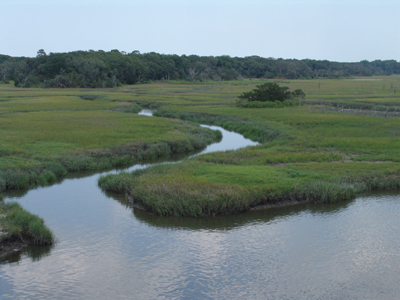
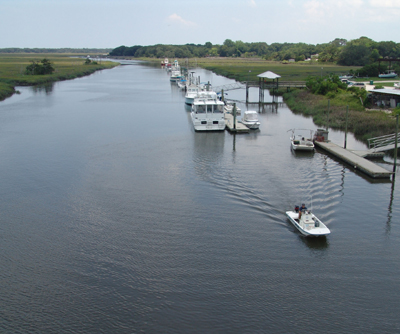 You can
only approach the island by boat from St. Mary’s and they said he would come
disguised so no one recognized him, except the locals say they all knew it was
him. Anyway, it’s a wonderful place and we loved to hear the local folk lore
and someday we’d like to come back and anchor our boat there and go exploring
and having a fine meal at the end of the day in the Greyfield Inn.
You can
only approach the island by boat from St. Mary’s and they said he would come
disguised so no one recognized him, except the locals say they all knew it was
him. Anyway, it’s a wonderful place and we loved to hear the local folk lore
and someday we’d like to come back and anchor our boat there and go exploring
and having a fine meal at the end of the day in the Greyfield Inn.